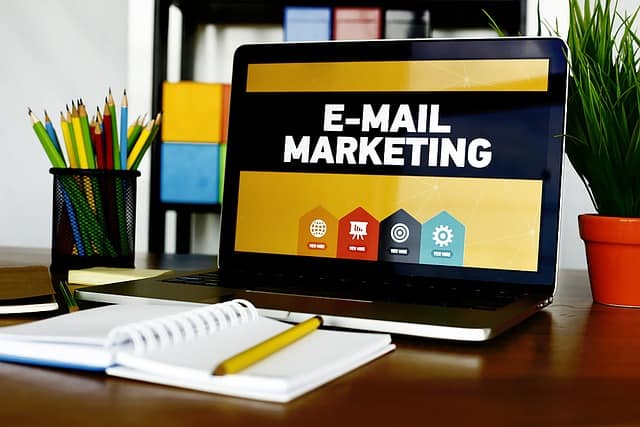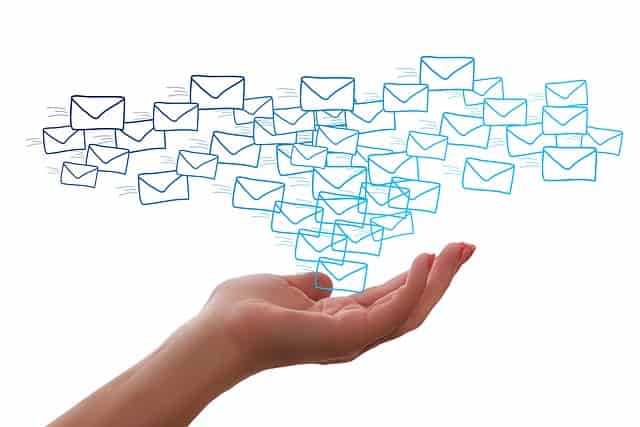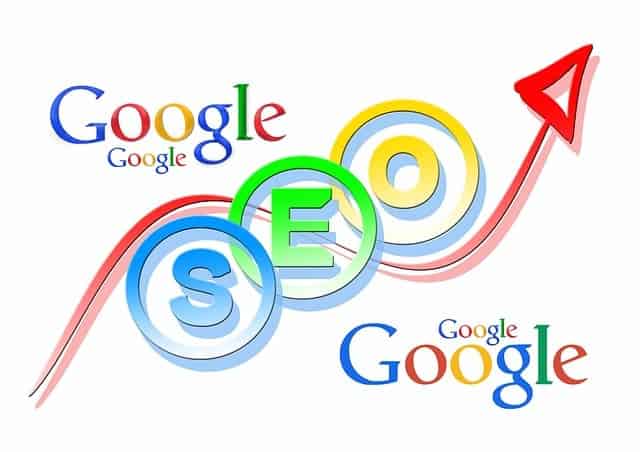AI Email Marketing: An 8-Step Case Study


When a stranger gives you their name and email address, they’re taking a risk on you. They hope you’ll serve them well rather than trying to exploit them. Using AI email marketing can help.
For many marketers, customer expectations are a lot of pressure, even if they have no ill intentions – because they know the recipient is expecting great things from them. You will spend a lot of effort building your list as an online entrepreneur.
You must develop an enticing lead magnet, build a high-converting landing page, and drive targeted traffic – all of which take time. So you don’t want to blow it by causing people to immediately unsubscribe because your emails aren’t deemed worthy or valuable to them.
Emails are such a personal form of content. Even though you’re using code to insert their name for personalization, it still feels like a more direct method of communication. So you have to craft your words carefully and over-deliver to keep people on your list and get them to convert into buyers for you, too.
There are different types of emails you’ll want to send to your readers, so we will cover an 8-step process that allows you to cater to the needs of your audience by nurturing them and showcasing your skills as a top niche marketer.
Welcome Your New Subscribers with AI Email Marketing
Your first impression is an important one when it comes to email marketing. The recipient may have hesitated to sign up, and when that initial email hits their inbox, they open it in apprehension, wondering if you’re going to be a typical spammer.
When they get that initial email, the bare minimum they’re expecting is for you to deliver the gift you promised on the sign-up page. But ideally, you want to go above and beyond – make them feel relief that you’re not like all the others and delightfully surprised at your first contact with them.
Your first email is where you can showcase the tone you’ll be using. Whether it’s a drill sergeant tone to push them into action or a caring and nurturing style, your email will set the stage for what’s to come.
The first thing you need to do is thank them! It’s a big deal to hand over your contact information, and while you might think they should thank you for the gift, you should be grateful they took a chance on you.
In addition to welcoming and thanking them for their subscription, you must immediately provide a link to the download or place to access your gift. You should mention that you’ve snuck a little surprise bonus into the file they weren’t expecting.
Getting more than what we asked for is always a pleasant surprise. You should say a little about what to expect as a subscriber. If you have a steady pattern of when and how often you email out, you can mention it.

If you do any marketing in this email, ensure you do it with a big incentive for your new subscriber. Your offer can be a one-time-only steep, site-wide discount on your store, for example – or a coupon code for an individual product.
And lastly, you need to ensure that your new subscriber begins forming a connection with you. So you want to invite them to connect with you – whether on a social media profile, your blog, a contact form, or directly via email.
Make them feel comfortable asking questions or reaching out because it shows how much you care. If you’re not used to developing emails like this, AI email marketing can help! You have to give the AI tool some information based on the above criteria.
First, let the AI, whether ChatGPT, Bard, or Jasper know the tone you’re going for. Then, tell it what you want to include, such as the thank you for signing up, link to the lead magnet (with the name of it), any incentives you’re adding, and the invitation.
Also, let’s have it write something acknowledging your audience’s pain point or goal based on what they signed up for. In our case, we will use a newbie marketer as an example, and the gift we’re giving is a report called Startup Success on a Shoestring Budget.
You can use any AI email marketing tool that works best for you. For our purposes, we’re going to use ChatGPT and writing emails is just one of its many abilities. Let’s prompt the AI by telling it the following:
“I want you to write a welcome email for my new subscribers who signed up for a report called Startup Success on a Shoestring Budget because they are strapped for money and want to build an online business. I’d like you to use an empathetic tone to discuss their struggles when you welcome them onto my list. Include a spot to provide them with the link to the gift download. I also want you to tell them I’ve included a special surprise bonus in the gift. And help them get started with a 60% off discount code for my store at website.com. Lastly, invite them to connect with me via email and make it sound warm and welcoming like they have a friend in their corner to support them. Make it sound like a personal friend-to-friend email, not a community of subscribers.”
You will likely need to tweak the response until you get what you want. For example, AI still used the word community, so I had to say specifically, “Quit using the word community.”
Why? Because I want the emails to feel personal, not like a mass response. Now AI came up with something I hadn’t included – a personal note about facing my own struggles.
You can use that as inspiration to include a small moment when you may have faced budget concerns, too. The subject line could have been better. It read: A Personal Welcome to Our Group of Entrepreneurs!
That’s not very personal. So let’s prompt AI to do better by saying:
“I don’t like the subject line. Write something better (give me ten options) that motivates them to start a business on a budget, but make it emotional, not spammy. ONLY give me the subject lines, don’t rewrite the entire email.”
ChatGPT loves colon marks, so every subject line is long. Prompt it to shorten it. If you don’t like the results, keep prompting it. I want to use “Welcome!” at the beginning of a welcome email.
But then there needs to be a call to action statement, so you can tell AI to create a list of subject lines with Welcome at the beginning, followed by an action statement for starting a business on a budget.
In the end, we’ll go with: Welcome! Time to Build Your Dream Business on a Budget! This call to action immediately lets the recipient know their welcome email has arrived and what it’s related to – the lead magnet they signed up for.
The body of the email that AI sent was almost perfect. I only changed one portion of a sentence where it talked about a group again. It said: “I’m thrilled to welcome you to our group of like-minded entrepreneurs.”
So instead, I changed it to this: “I’m thrilled to be working with a like-minded entrepreneur who sees the importance of keeping costs down and profits high.” That way, the recipient seed this as a friend-to-friend communication and not a mass email to everyone.
The only other thing you may want to tweak is adding your own story – just a line or two, not an entire memoir – and a tiny bit about how often they should expect to hear from you with tips and advice. You can prompt AI to include this if you want or write it yourself.
Develop an AI Email Marketing Series You Can Use for Your Subscribers
After writing your welcome email, the next step is to let AI help you develop an email series. An email series is something all marketers should have on hand. Some people make this the gift they will give in exchange for the subscriber’s name and email address, but most use a lead magnet report instead.
You can also have an email series written ahead of time by AI. If anything arises and you need to take some time off, such as for travel or a health issue, you can queue up this series and let it nurture your list for you on autopilot.
The first thing you want to do is have the system help you think of a good topic for a series that would go over well with your subscribers. You can prompt the AI like this:
“Give me a list of 10 topics that would be suitable for an email series for an audience of new online entrepreneurs trying to build a business online on a shoestring budget.”
It delivered the following results (with more detail that I’ve left out):
- Introduction to online business
- Digital marketing on a budget
- SEO for beginners
- Creating content that converts
- Building a solid brand
- Customer acquisition strategies
- Maximizing conversions
- Scaling your business
- Outsourcing on a budget
- Maintaining work-life balance
An AI email marketing series is something where you can sometimes get the topic to slant toward your target audience (people on a budget starting their own business), and sometimes it doesn’t make sense to have that as your focus.
For example, with the first one, you could tailor that email series to be budget-minded. You could do the same for the one about SEO, creating content, and others. But some of them, such as work-life balance, may be good marketing topics in general, but they don’t have anything to do with a budget.
If you ever wonder how to tie something in, ask the AI. I prompted the machine this way:
“How would I tie the 10th one into a topic of marketing on a budget? I’m not sure how work-life balance is related to the budget.”
Amazingly, it delivered some intelligent results. It told me that if they manage their time wisely, they’ll get more done quickly and save money. It also said that operating on a budget can be stressful, so helping them avoid burnout can make them more productive and profitable.
And lastly, it advised me that work-life balance is vital in staying motivated, which is sometimes hard to do when everyone else is pouring money into their business. You have to do things with limitations.
So it’s possible, but it still needs to be my favorite slant. You can ask AI:
“Which of those ten topics do you think you could outline a 7-part email series for?”
It will respond: “I believe Digital Marketing on a Budget would be a great topic, and here is a possible outline for the series.”
If you want to see what it could do with the others, prompt it! Say something like:
“Can you do a possible outline for the one on SEO but make it all about SEO on a budget?”
It certainly can deliver some results for you.
We’ll go with Digital Marketing on a Budget. But let’s prompt AI to create a better name for our series. I told AI:
“I want to do Digital Marketing on a Budget, but can you give me ten better names for the series and keep them pretty short?”
It delivered two that stood out: Budget Marketing Hacks and Low-Cost Marketing Mastery. I like the hacks option better because it’s a buzzword many people use in this industry, so let’s go with that one.
I then told AI to rename the outline to include the wording Hack #1, Hack #2, etc. You should review the results because sometimes, what it provides will not necessarily align with what you promised in the series.
For example, AI gave me a list of seven email topics, but the first was simply an introduction to budget marketing. That is not necessarily a tip or hack, so I asked to replace it with an actionable recommendation.
Now, instead of the subject for email #1 being “Introduction to Budget Marketing,” I have a real hack – “Stretch Your Budget By Repurposing Content.” Another of the hacks it provided was “Email Hacking Strategies.”
That’s not a hack. So instead, we’ll prompt AI by saying,
“On hack #5, can you give me an actionable hack or tip for email marketing regarding budgeting?”
The first result was pretty much the same.
It simply changed to “Increase Email Open Rates with Creative Subject Lines.”
You must be willing to call out the AI machine when it doesn’t deliver for you. I responded, “How does that have anything to do with the budgeting?”
Luckily, the AI tool will apologize for the confusion and give you an actionable tip like you wanted. In this case, it changed to an actual hack: “Design a High-Converting Email Template with Free Tools.”
Once you have your AI email marketing series mapped out and in a logical order (if applicable), have AI start writing the emails. You can try this one of two ways. The first is to say:
“Write Email #1: Hack #1: Stretch Your Budget By Repurposing Content.”This is an info alert. Lorem ipsum dolor sit amet, consectetur adipiscing elit.
Or, if you know you want certain things included, you can say something like:
“Write Email #1: Hack #1: Stretch Your Budget By Repurposing Content”. Ensure you introduce the problem, explain repurposing, and offer valuable implementation tips. End with a compelling call to action.”
With the first option, AI does a reasonably good job but doesn’t deliver enough information. It just tells people to repurpose content, like turning videos into text. The second method provides excellent information and three specific tips or hacks.
To complete this task, you want AI to write you a teaser email for your subscribers announcing the upcoming series. Prompt this:
“I want you to create a teaser email for this series. Don’t tell them everything in it, but make them look forward to getting the emails for the Budget Marketing Hacks and excite how it will help them.”
You’ll be sending this email out first – getting subscribers excited about the value you’re about to provide and ensuring they know to be on the lookout for your emails. When I had Ai write this email, even though I told it not to say to them what was in it, it did mention a couple of things.
So I deleted that. It also told people to sign up for the emails, but they are already on my list, so I deleted that sentence. These errors are why you need to read through all of the content that any AI machine delivers for you.
Promotion Emails Are a Breeze Using AI Email Marketing
You wouldn’t believe how many people are intimidated by the thought of marketing to their subscribers. Promoting products to someone who has granted you the ability to contact them via email sometimes makes you pause because you don’t want to appear as a spammer.
However, you are in this business to make money. Promotional emails are part of the package, and most subscribers understand this. The key is to ensure you have plenty of value going out to them so that you are not only pushing products without giving in return.
AI has no problem and no hesitation in creating promotional emails. Whether you send out a promo for your product or to someone else’s product you promote as an affiliate, you must prompt it to craft the words for you.

So your example target audience in this report is newbie marketers on a budget. When you think about items you want to promote, you first want to pick the best product for their needs.
Not only do these individuals need quality, but they need reasonable pricing, too. As an affiliate marketer, consider something that will give you recurring commissions.
So promoting an email autoresponder system would be a wise choice. Start by asking AI to answer a few questions for you, such as:
- “Why is list building so important for marketers on a budget?”
- “What features are most important in a good email autoresponder?”
- “What reasons could I give why Aweber is the best autoresponder for newbie marketers on a budget?”
Now prompt it to come up with the promotional email by saying:
“Using all of that information, I want you to write a promotional email that first introduces the concept of why having a list is so important, followed by the importance of a quality autoresponder system, and include a promotional slant to talk about why Aweber is the tool newbies on a budget should consider for their email marketing. Be sure to deliver a strong call to action to get them to invest in Aweber, even on a budget – especially since they get up to 500 subscribers on one list at no cost when starting.”
Sometimes you can ask it for all of the benefits of a product or feed it information about special deals you want to include. Or, you can ask it to highlight why one product is better than another.
For example, many newbies often go with MailChimp thinking it has the best deal for the newbie slant. So you can prompt AI with:
“Tell me why Aweber is a better email autoresponder than MailChimp.”
It will give you a list of reasons, such as:
- Better deliverability rates
- Advanced segmentation
- Strong automation features
- More affordable pricing
- Better customer support
So then your promo email might take a different slant, with a subject line like, “Big Mistake, New Marketers Make with Email Marketing.” And the person will open the email to see if they’re making that mistake, and your slant can discuss it’s the first step that often results in an error – who they pick as their autoresponder system.
AI Email Marketing Can Help You Deliver Subscriber Perks
When you own a list of subscribers, you must treat them well and nurture them in their journey. One way you can do this is to find or create perks for your subscribers who stay loyal to you.
You can show your gratitude to your subscribers in various ways. For example, you can give them unexpected freebies at times other than their welcome email.
You can also give them access to gated, password-protected content you post to your blog or on another website that the public cannot access.
You can have your AI system create an email that announces a unique benefit to your subscribers. Let’s pretend you’ve completed a case study on how to start an online business for under $20 per month.
Let’s prompt AI to write an email announcing this and sharing the value in a way that makes the subscriber feel special. Type in:
“I’ve created a password-protected case study only for my list of loyal subscribers that teaches them how to start a business online for under $20 a month. Make them feel exceptional and emphasize how no one other than my subscribers can access this. Also, go into how much it will benefit them.”
Send Authoritative Emails to Bolster Your Niche Leadership
For this particular step, you will create one or more emails that showcase your leadership as an authority figure in your niche. Your purpose here is to prove to your subscribers that you pay attention to their needs and that you will notify them whenever there is something helpful that they need to know.
There are two different ways to go about this. If you want to deliver some evergreen information, you can use ChatGPT. But it is limited to data from 2021, so if you wish to do something trending or newsworthy, you’ll need to use a tool like Google’s Bard.
If you go to Bard, we can prompt it:
“What’s some cutting-edge or new information that would help online entrepreneurs on a budget?”
Bard will reply with different results, one of which includes Artificial Intelligence.
It’s true – that’s a topic everyone is discussing, and it’s cutting-edge insight. Now you can take that idea back to ChatGPT. So you can then prompt ChatGPT with this:
“Write an email for new marketers on a budget about ten ways AI can help them save money in their marketing budget.”
You can give any tips and newsworthy information. If the recommendations aren’t enough to make a substantial impact, pair it with additional content that you ask AI to create, such as prompting it for data on how many people use AI in their business, the accuracy and quality of AI, and so on.
Create Complete AI Email Marketing Newsletters
Many people send more than just a single focus email to their lists. Instead, they entice people to sign up for a newsletter. A newsletter will have different sections with a unique focus, and the categories remain the same each week while the information in each change.
So, if you need to become more familiar with what an email newsletter includes, you can prompt AI like this:
“I’d like to write a marketing newsletter that I email out once a week for newbies on a budget period. What sections should I have in my newsletter?”
AI will give you a list that includes things like:
- Welcome message
- Tip of the week
- Featured resource
- Case study or success story
- Q&A or Ask the Expert
- Recommended reading
- Industry news
- Subscriber spotlight
Now that you can use some good ideas, pick what you want and prompt AI to do the work! First, ask it to:
“Give me some ideas for names for my newsletter.”
It gives many ideas to pick from the list, like The Budget Marketer, The Marketing Penny Pincher, The Thrifty Marketer, Marketing on a Dime, etc.
I like the plain one – The Budget Marketer. Next, tell AI which one you’ve chosen and which sections you want to include in your AI email marketing newsletter from the list it gave you. We’ll include the welcome message, the tip of the week, featured resources, Q&A, recommended reading, and industry news since we’re not going into specific subscriber success stories.
Write your prompt like this to inform AI of your project:
“I’m choosing to name the newsletter The Budget Marketer. I’ll have the following sections: welcome message, the tip of the week, featured resource, Q&A, recommended reading, and industry news. I want you to write the newsletter, starting with the welcome message first.”
Initially, AI delivered a welcome message that rehashed what they would find in the newsletter. So I re-prompted it with these instructions:
“I don’t want a rehash of what’s in the newsletter. Rewrite the welcome email to touch on their pain points with marketing on a budget and end the message with an invitation to enjoy issue #1 and send in any questions or comments they may have.”
With those specific instructions, it wrote a much better welcome that hit on the reader’s struggles. Next, you can ask AI to give you ideas for each section as you go, then choose which one you like and have it written.
For example, instead of just prompting AI with:
“Now write the tip of the week,”
tell it:
“Give me ideas for the tip of the week.”
Then you choose what goes into it, allowing you to control your teaching.
We will go with this:
“Attend virtual events on a budget: Save money on travel and accommodations by participating in affordable virtual events, such as webinars or conferences, to network with other professionals and learn new skills.”
Prompt AI to expand on this week’s tip like this:
“I like the tip for attending virtual events on a budget. Write this section of the newsletter and explain why this is a great option for newbies on a budget, how they feel left out not being able to attend in person, and how much cheaper virtual options are.”
It will give some great advice. You may have to continually remind ChatGPT or any AI email marketing tool to slant it for your exact demographic (in this case, marketers on a budget) so that it all ties in together.
Repeat the process for all sections of the email newsletter. Ask for ideas, pick one, and have it write that section. Also, keep a file of the ideas it gives you to immediately know what to ask for in the second, third, and subsequent issues.
For the recommended reading section, Bard might give you specifics, like naming specific blogs, books, and courses – while ChatGPT might say, “Read blogs, read books, and read courses.”
Check The Facts Provided
If they give you specifics, make sure that a.) they still exist and b.) they are what AI says they are – and a good fit for your readers of this newsletter. Bard suggests The Lean Startup as a book.
After checking it out, you can see that it does exist and is by Eric Ries, and then you can prompt AI like this:
“Write the recommended reading section and recommend a book called The Lean Startup by Eric Ries. Do you know about the book?”
Now remember, AI will lie. So double-check that what it gives you back is correct. And it was. For the industry news section, go back to Bard, which is current. ChatGTP’s database is only up to 2021, so let’s prompt Bard like this:
“What are some newsworthy tidbits recently for a newsletter about free tools or strategies in the internet marketing industry? What about the recent news that could impact marketers that has to do with profits or costs?”
It gives you many ideas, but one is that inflation is rising. We’ll go with that one and have AI expand on it. This time, we’ll use Bard to complete the content because ChatGPT isn’t up to date, and it did a fantastic job of providing tips – but if you want it to add specifics about the current inflation situation, you can ask for that, too.
Warming Up a Cold List Is Easy with AI Email Marketing
Sometimes, a situation occurs where you may not have contacted your list in quite a while, and it has grown cold. You have to reconnect with your subscribers, which can sometimes feel awkward.
Instead of putting yourself out there and not knowing what to say, let AI do the work for you! First, explain the problem to your AI tool and ensure it knows how much you do or do not want to share.
It also needs to know your goal in reconnecting with these subscribers, what kind of tone you want to use, and any other specifics you want to include, such as a gift for being patient or staying subscribed.
Let’s prompt AI like this:
“I have a list of subscribers I have not emailed in months. I had some unexpected responsibilities arise that kept me from working online. Please write an email that warms up my cold list. I want the tone of the email to be apologetic yet enthusiastic about being back and being able to help them with their goals. You should also mention a gift I want to offer them for being patient and staying subscribed. It’s called “7 Ways to Start Earning $100 a Day on Autopilot.”
It did an impressive job of writing the email with zero corrections or tweaks needed. It had an excellent tone of apology yet sounded enthusiastic and positive. You want to avoid sending an email moping about your problems.
If the results you got back were lacking, you could re-prompt the AI tool and tell it to be more apologetic or enthusiastic, etc. Don’t be afraid to redirect the robot because it doesn’t have feelings and can correct itself based on your input.
Use AI to Come Up with Relationship-Building Emails
Sending value in your emails is the crux of how you should be marketing to your subscribers. However, business is not all about facts, figures, strategies, or tools. It also depends on the people and your relationships with them, especially in this industry.
You want to periodically send out emails that make your subscribers feel connected to you on an emotional level. So let’s prompt ChatGPT like this:
“I’d like to send a relationship-building email to my list of struggling marketers on a budget. What things could I discuss that would endear them to me or make them feel like I have their back and support them?”
Now if you already have a topic you want to bond with them over, you can undoubtedly feed that data into your AI tool and have it whip up something for you. But this is handy in cases where you want to have that bond and loyalty, but you need to figure out what to say.
AI will return results like:
- Your struggles
- Success stories
- Personal touch details like hobbies
- Encouragement
If you want to put in some basic details about some struggle that you went through that they can relate to, you can have AI write it for you. But in our case, we will go with the last option, having it write an encouraging email to your list.
First, you want to ask the AI tool what type of emotions marketers often feel when they are limited by a small budget and trying to build a business. It will tell you answers such as frustration, anxiety, insecurity, guilt, and, oddly – optimism.
You can select one of those and have the AI tool write your email to encourage your subscribers who feel that emotion. If you don’t want emotion, you can use a specific situation, such as shutting down your payment platform or being confronted by a rude customer.
For our example, we will prompt AI like this:
“My list of marketers on a budget often feel insecure in trying to be competitive in a niche when they have no money to spend on things others are buying, like top-notch tools, courses, coaching, etc. Please write an encouraging email that starts off talking about their problem and the emotions that come with it and then motivates them to realize it’s not as big of an obstacle as they may think. Share tips with them on how to get past this defeating mindset.”
AI may have excellent information when it delivers the results, but it reads a little stale. Sometimes you have to prompt it to be more emotional.
You can tell it to paint a picture for the reader about how they are feeling, or even insert some of the emotions you know, as a human, they may feel – such as shame in not being able to afford the same things their competitors are using.
With AI sitting there to use as a resource, there’s no reason to ignore your subscribers or delay until you have a sudden burst of ideas to communicate with them.
As you can see, using AI email marketing correctly is more complex than asking it to write an email. You have to do a lot of brainstorming on your own and prompt and redirect it whenever necessary.
You’ll also want to review all the content it creates, extracting things that don’t fit and adding wording that sets you apart from a machine or your competitors.






